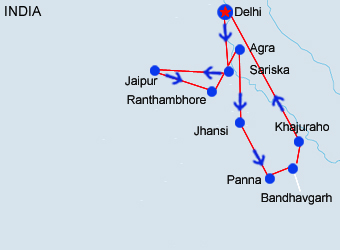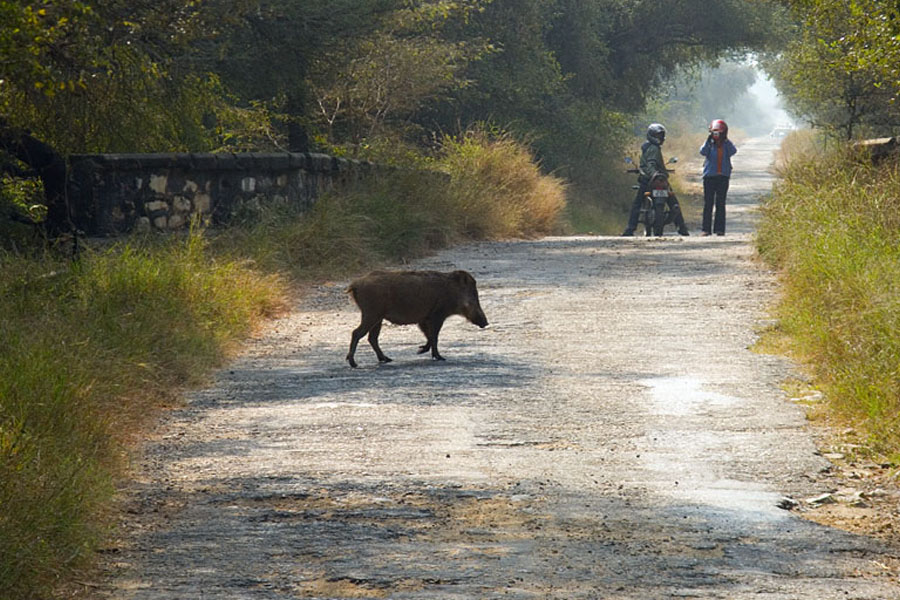Day 01 - Arrive Delhi
Arrive Delhi.
Meeting on arrival and transfer to the hotel.
Overnight at the Hotel.
Day 02 - Delhi
Full day sightseeing tour.
Sprawling on the banks of the river Yamuna, Delhi, the capital of India, this city conceals within its bosom the remains of civilization that flourished over the last three thousand years. Since those legendary days, many dynasties and rulers have left the legacy of their past that survives in the many monuments left behind by the regents.
Old Delhi's landmarks are Red Fort built by Emperor Shahjehaan in 1638 AD, Jama Mosque, the largest in India; also built by Shahjehan, Raj Ghat and Shanti van - the cremation sites of Mahatma Gandhi and Pt. Jawaharlal Nehru, Chandni Chowk - the main shopping hub of Old Delhi.
In New Delhi, visit Qutab Minar, one of the earliest remains of Imperial Delhi (13th century AD) Humayun's Tomb-the fine monument believed to be forerunner of Taj Mahal, India Gate, the 42 metre high arch that was raised as a memorial to soldiers, Parliament House, President's House, Secretariat and other Govt. Building and Connaught Place, the oldest city centre shopping hub built during British Raj era.
Day 03 : Delhi-Sariska drive, 200 km
After breakfast, drive to Sariska
On arrival, check-in at the hotel.
Afternoon jeep safari.
In Sariska, wildlife observation at the water holes is fascinating during the hot days of April, May and June. Water requirements increase and wildlife activities get restricted to the water holes, specially around Kalighati and Slopka. Sambars, chitals, nilgais, chausinghas, jackals, wild boars, langurs etc. visit water holes throughout the day. The tiger appears around dusk or during the silence of the night. Besides leopard, the hyena, jungle cat and wild dog are the other main predators.
Day 04 : Sariska-Jaipur drive, 110 km
Morning drive to Jaipur visiting en-route Amber Fort.
Set in a picturesque location. Amer is a fascinating blend of Hindu and Muslim architecture. Built in the 16th century by Raja Mansingh in red sandstone and white marble, the palace complex has some very interesting sections. Jai Mandir, Sheesh Mahal, Sukh Niwas, Ganesh Pol and Temple of Kali are some of the prominent areas of interest. Elephants are provided to ascend the fort.
Check-in at the hotel.
Rest of the day free.
Day 05 : Jaipur-Ranthambhore drive, 185 km
Morning city sightseeing tour.
The city was planned and built by Maharaja Jai Singh, the notable astronomer 260 years ago. The City Palace, the home of the erstwhile royal family, the Observatory, RamNiwas Gardens, Hawa Mahal or the Palace of winds built in 1799 by Maharaja Sawai Pratap Singh and Birla Temple are the most important tourist sites.
Afternoon drive to Rantambhore.
Check-in at the hotel.
Day 06 : Ranthambhore
Morning and afternoon jungle safari.
Ranthambhore National Park is part of Ranthambhore Tiger Project which spreads in an area of 1344 sq km. Out of which 282 sq km of dense forest, surrounded by the Vindhyas and the Aravalis hills, is assigned to Ranthambhore National park.
The wildlife species found in this area include chital, sambar, blue bull and chinkara. Sambar deer is the pride of the park. There is no other park in Asia, where these largest of all Asiatic deer can be seen so frequently during day-time. Wild boars and langurs are a common sight. Among the reptiles, crocodiles can be seen basking in the sun near the lakes.
The Tiger is the biggest attraction of this park. Ranthambhore is one of the best parks in the country for sighting the most beautiful elusive Tiger. Other carnivores in the park include leopard, hyena, jackal, fox, caracal, jungle cat, sloth bear and ratel.
Day 07 : Ranthambhore-Agra drive, 318 km
Morning drive to Agra, en-route visit Fatehpur Sikri.
The beautiful city was planned and erected by Emperor Akbar in 1569. The story behind the city relates to birth of his Son Salim who was named after a Muslim Saint - Sheikh Salim Chishti. Emperor Akbar hearing his renown, had visited the Saint, asked of the blessings of a child. When a son was born, he decided to built a city near the place where the Saint lived. The city was abandoned after 14 years due to shortage of water and growing population. The imposing pavilions, Mosque, massive Buland Darwaza (Gate), Panch Mahal and other buildings are worth a visit.
On arrival, check-in at the hotel.
Day 08 : Agra
Morning sightseeing tour.
Taj Mahal is the finest example of Mughal architecture. A UNESCO World Heritage site, this immortal monument, the inimitable poem in white marble is the true expression of love of Emperor Shahjehan for his queen Mumtaz Mahal. The monument was completed in 1653 AD and thousands of workers and artisans were employed. It took little over 20 years for its completion. Agra Fort's importance can be judged with the great names of Mughal dynasties Humayun, Akbar, Jehangir, Shahjehan and Aurangzeb who lived here. The imposing structure on the banks of the river Yamuna is replete with priceless examples of craftsmanship in the Mughal period. The beautiful pearl Mosque, Diwan-e-Am, Diwan-e-Khas, Jehangir palace, Moti Masjid are to name a few that form the part of this great fort.
Afternoon at leisure.
Day 09 : Agra-Jhansi-Panna
Morning transfer to railway station for train to Jhansi (0818-1040 hours)
Meeting on arrival and drive to Panna Tiger Reserve (180 km)
Rest of the day free.
Day 10 : Panna
Panna is located in the Vindhya range, this tiger reserve spreads into two revenue districts, Panna and Chhatarpur. Like Bandhavgarh, Panna was also the hunting reserve of its erstwhile rulers of Chhatarpur and Bijawar princely states. The protected area was brought under Project Tiger in 1994. Panna is rather an open, dry landspace, with the topography and water distribution governing the spatial presence of wild animals. These places provide adequate cover for wild animals. Vultures and other raptors roosting on cliffs along the river course are a common sight in Panna. The fauna consists of tiger, leopard, Chowsingha, Sloth bear, Nilgai, Chinkara, hyena and small groups of Chital. More than 200 species of birds have been spotted. Both Gharial and Mugger are found in the Ken River.
Morning and afternoon jeep safari.
Day 11 : Panna-Bandhavgarh drive, 255 km
Morning drive to Bandhavgarh. Check-in at the hotel/resort.
Set amidst the Vidhyan ranges, the Park has a series of ridges running through it. It is spread in a area of 437 sq.km. About half the Park is covered with fine stands of sal, while mixed forests are found in the higher reaches of the hills. Stretches of bamboo and grasslands extend to the north.
An ancient fort up on a precipice 800 metres high, dominates the Park. Bandhavgarh was declared a Park in 1968. This is where the famous white tigers of Rewa were discovered.
Other inhabitants of the park are muntjac, jungle cat, ratel, hyena, porcupine, the rhesus macaque and the blaack-faced langur, nilgai, chausingha, chital, chinkara, wild boar, fox and jackal. About 150 species of birds are also found here and include the migratory birds that arrive in winter like the steppe eagle and various water-birds.
Afternoon jeep safari.
Day 12 : Bandhavgarh
Morning and afternoon jeep safari.
Day 13 : Bandhavgarh-Khajuraho drive, 280 km
After breakfast, drive to Khajuraho.
Check-in at the hotel.
Rest of the day free.
Day 14 : Khajuraho-Delhi flight
Morning sightseeing tour.
Khajuraho, once the great capital of Chandela, now a quiet town, Khajuraho temples here were built during the Chandela period from 950 to 1050 AD. Almost intriguing as the sheet beauty and the size of the temples is the question of why and how they were built here as Khajuraho is isolated, 1000 years ago as it is even today. The temples are superb examples of Indo-Aryan architecture and depict images of gods and goddesses, warriors and musicians, real and mythological animals and in great detail - women and sex. In between are the mithuna, erotic figures running through a whole Kamasutra of positions and possibilities.
Transfer to airport for flight to Delhi and onward connection.











